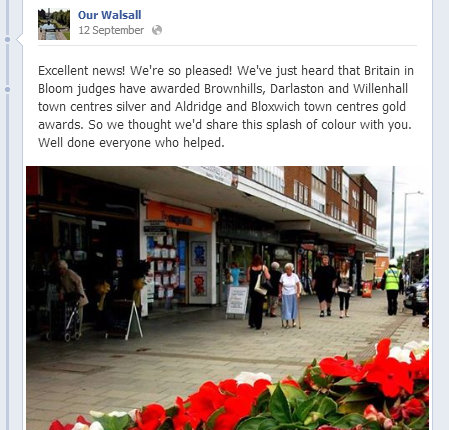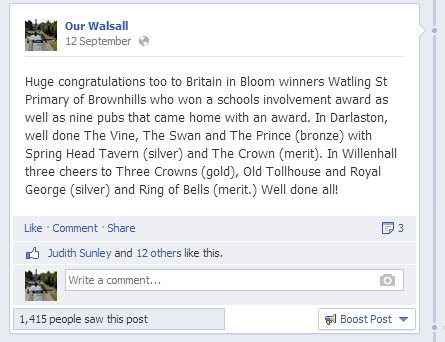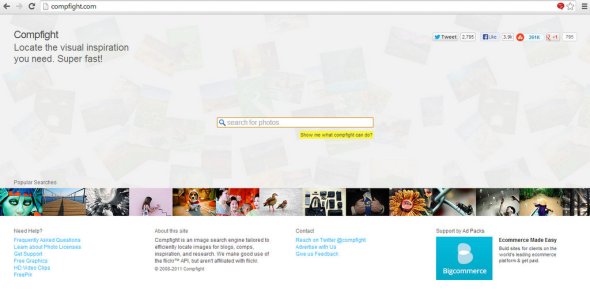How much difference does it make to add a picture to a Facebook update? Lots. Or to be more precise 147 per cent.
That was the figure when we posted two updates within minutes on a broadly similar subject.
The first celebrated a Britain in Bloom win for towns in Walsall Council’s boundaries with a picture of flowers in Aldridge drew 37 shares, 88 likes and an audience of 3,,508 on the authority’s Facebook page. I’d be the first to admit that this image isn’t the most arresting in the world. But it says both place and colour and that’s enough.
The second posted without a picture a few minutes later celebrated recognition in the same competition for a school and nine pubs. That drew four shares and 12 likes with a reach of 1,415.
Okay, the subject matter is slightly different: towns compared with school children and popular pubs. But there’s enough there to draw some conclusions.
It’s an approach that the ECB takes when the England Test team are playing. It’s something I’ve written about before. Rather than just posting a text score update they post an image of the man of the moment with text too.
If you can, adding text through a simple picture editing tool is a great idea. A phone number or a message works. For that you can use Google’s own Picasa3 software.
What do the numbers teach us?
Firstly, sharable content is important on Facebook and in this case so is a celebratory upbeat message.
Secondly, people are really keen to share messages. Obvious. But it’s important to remember this.
Thirdly, having a stack of pictures available to you is helpful.
But where do you source pictures?
Google images?
This is potentially a bit of a minefield. No, you can’t go to Google images right click and save. Copyright applies to images online just as much as they do online and people have ended up in hot water. Google also allows people to search for a specific image online so if you think you’ll be safe hiding in the fire hose of information that is the web think again.
Your image library?
The basic fact under the 1988 Copyright and Designs Act is that when someone takes a picture they retain copyright. Even if you have paid them. If you’ve, say, commissioned a freelance photographer to take some shots of a night market you are buying a licence to use them for a specific purpose. That can be as broad as marketing and promotion on your website, in print and with the local paper. It may not include social media and you’ll need to check this with the photographer. This NUJ link on copyright and photography is helpful.
Your own?
And by your own I mean one that you’ve taken yourself with your smartphone or camera. Handy if you have time and ability. Not so good if you need an image of flowers in a town centre at a moment’s notice.
Stock photography?
You can, but it costs. Istock is one example of an online image library but there are charges. It’s even more for a Getty shot.
Creative Commons?
One of the great things about the social web is the ability to share. Creative Commons licences are licences which a photographer – amateur or professional – can attach to an image when they post it onto an image library. They’re basically saying that they’re happy for their image to be re-used under certain laid out conditions. The US government, for example, releases virtually all images with a creative commons licence.
So where do I go for creative commons images?
Without doubt the best place on the web is compfight.com. This is a site which works with Flickr’s API to search for key phrases and words. It also searches through a variety of filters from the non-creative commons to the creative commons to the most liberal of all – commercial creative commons which allows a broader re-use.
It’s not great for specific locations, I admit. There’s a handful of images creative commons for Walsall, for example. But it comes into its own when you need a stocjk pic, like boxing gloves, a coffee cup or clouds in a sky.
It’s a brilliant site. But please, don’t forget to attribute and share where the picture has come from. It’s what makes the social web work.
Legal disclaimer: Always, if you need specific legal advice go and see a lawyer rather than base it on this or any other online advice.







An image is worth a 1,000 words. More often people will be drawn to pictures with interesting content rather than a long paragraph of words. I use most of my own photos and many from Google images. Also flicker contains a lot of free images.